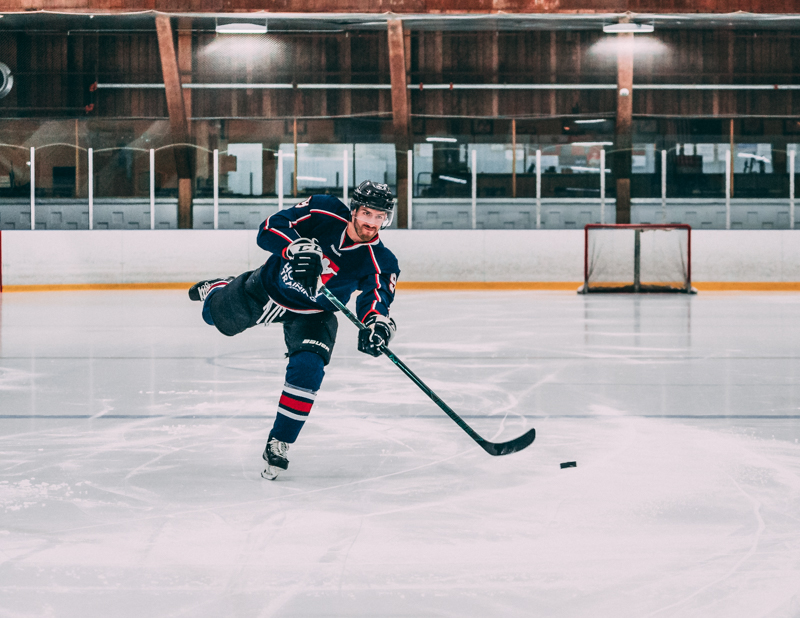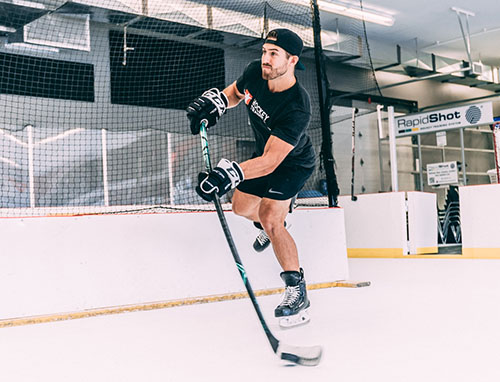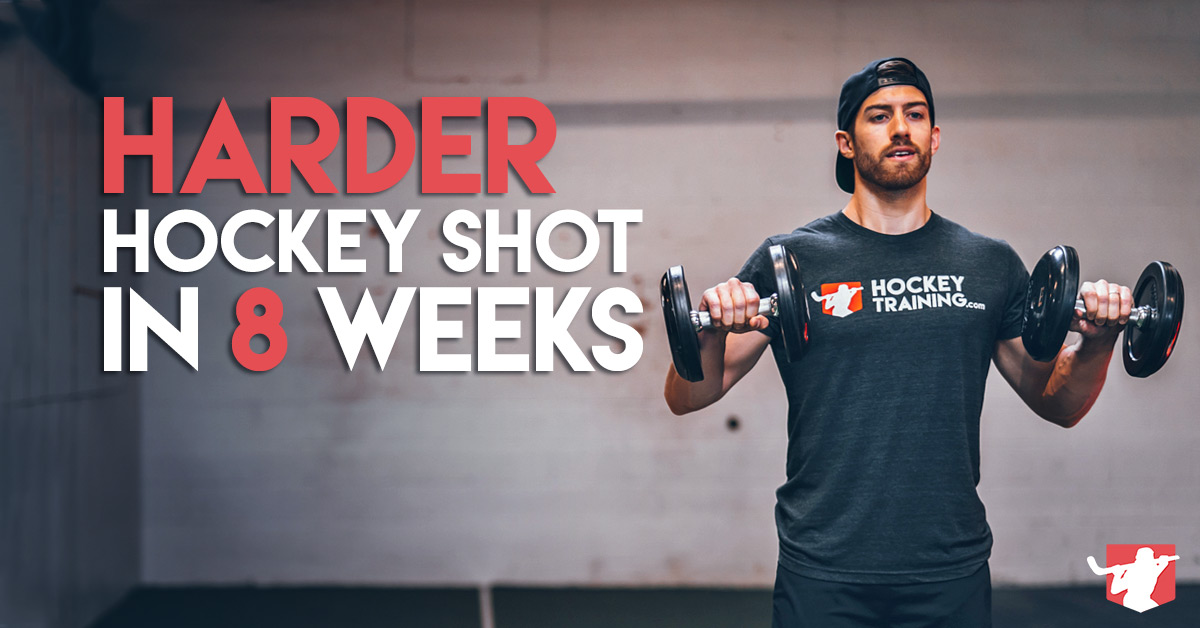When it comes to hockey performance, you need to have the ability to express maximal force in the shortest timeframe possible.
The faster you can express force into the hockey specific planes of motion, the more explosive and powerful you’re going to be on the ice.
The shot is no exception here.
Here’s what we’re going to take a look at today:
- Best Shot Power Exercises
- Using Grip Strength To Improve Your Shot
- 8-Week Grip Strength Training System To Get A Harder Shot
Proper hockey training requires understanding the energy systems and muscle recruitment that is used out on the ice and reverse engineer those steps accordingly so we can train exactly how we need to in order to improve your performance, and not just make you stronger.
For the shot, it very much comes down to your rotational power, posterior chain development, and grip strength.
Understanding the Shot
The fundamentals of improving shot power should revolve around all of the muscles that are loading and exploding during the shot.
Watch any hockey player who is known for his shot, the motion will always begin with the rear leg being loaded, a rotation of the hips and core first backward and then progressively forwards as they fire through the shot through with the arms and lats as the puck explodes off the stick.

In the case of improving the force output of this process; the shot is a low load, high-velocity rotational power movement, and should be trained as such.
Additionally, it is heavily supported by relative strength, specifically in the lats, hips, and core.
In large part, the entire body’s relative strength is important in the shot as it is truly a total body movement depending on many different links in the movement chain.
But, if we are creating a hierarchy of what is going to create the biggest impact in your training, the lats, hips, core, grip are likely to rise right to the top…. with rotational core power being on the top of that totem pole.
Knowledge is power.
You now know what muscles and actions you need to do in order to improve your shot power and take your game to the next level.
Now let’s put some of that knowledge into action and take a look at some of the best exercises to increase your hockey shot power…
The Best Exercises For Increasing Your Shot Power
Wide Grip Pronated Lat Pull-ups
Although I am going to briefly discuss all of your back work here, my favorite exercise in this category to improve shot power is without a doubt the wide grip pronated pull-up (above) as it checks so many boxes:
- Grip strength
- Core strength
- Posterior chain development
- Emphasis on lats
This combination makes this exercise one of the best “bang for the buck” hockey shot power movements in the industry today.
With back training, we don’t just stop at the pull-up though…
Because of the many different muscle groups in the back, your workouts need to include an even distribution of both vertical and horizontal pulling exercises as these are all going to play into your shot power.
The best vertical pulling exercises would include all variations of pull-ups, chin-ups, and lat pulldowns.
The best horizontal pulling exercises for hockey players include barbell row, pendlay row, rope face pulls, dumbbell rows, seated cable row variations, and the chest supported row machine.
Due to the wide range of fiber distribution in your back muscles, it is wise to incorporate a range of 6-20 within your programming.*
*This is not to mean your rep range for all workouts should be 6-20, I mean this is the range that is best to work within throughout the year. For example, for one phase your rep range could be at 6-8, but the next could be 18-20.
Medicine Ball Rotational Scoop Toss
Nothing replicates the low load/high-velocity nature of a hockey shot better than medicine ball throw variations.
This is arguably the most sport-specific exercise you could ever use to improve shot power.
Here are some important notes on technique and loading/exploding:
- Rotate your core and trunk so the front of your body turns horizontally as you get your back hip over your foot and load your rear leg
- Push off your back leg directly towards your front leg while simultaneously exploding into trunk rotation throwing the ball towards a wall as hard and as fast as you can
- It’s just as important to be able to control and decelerate the ball as it comes flying back to you. If you have trouble doing this, you need to incorporate some more plank work into your programming because core rigidity is crucially important for injury prevention
- When you do catch the ball, control it, rotate back and load your rear leg again, but pause for 1-2secs before exploding into another throw again
This is how you can best use the medicine ball to improve your shot power.
Don’t forget the pause at the end of the movement as it teaches you to load and explode with all of your force, and not just bang off a bunch of reps.
Think about if you’re in a hockey game, do you get to just fire off 10 slap shots in a row?
Or is it one controlled load and explode effort?
We need to pause so you can focus on creating power, and not rotational speed conditioning.
Deadlift
The deadlift is one of the most popular movements in the entire exercise field.
It incorporates nearly every single muscle in the body and the weight you are able to add to the bar allows for a massive stimulus for muscle strength and power to be created.
This exercise absolutely smashes the glutes, legs, core, arms, grip, and the entire back.
Anything that’s producing whole body power (which includes the hockey shot) will be supported heavily by some good deadlift work.
Do not fall for the claims that it is bad for your back, as this has been debunked in the literature many times over. It’s not the deadlift that is bad, it’s how you perform it.
Like any other exercise, if you perform it like an idiot you’re going to get hurt.
The deadlift should be a mainstay in your yearly programming and should be trained in multiple variations for the most complete development.
Sumo deadlifts, conventional deadlifts, trap bar deadlifts, Romanian deadlifts, and any other variation you can think of should all make an appearance from time to time and be progressively overloaded to ensure optimal carryover into your shot power.
Using Grip Strength To Improve Your Hockey Shot
Although grip training seems simple on the surface, it’s a little more complicated then most people give it credit for.
You can’t just grab something hard and think that it trains your grip strength effectively over time.
For example, wrist curls and wrist roller exercises are great for the forearms, but they don’t specifically train the muscles used in gripping.
The muscles you need to concentrate on are located in the hand and they don’t run across the wrist (from an anatomical perspective).
I have had coaches suggest to me in the past that they just have their athletes squeeze a tennis ball, but here we have three major issues:
- You only have one option for the degree of resistance being applied.
- The more you squeeze the ball, the weaker it gets over time. So, even though you are getting stronger (which would necessitate a need for greater resistance) the ball is getting weaker (which kills your ability to overload your grip muscles).
- There is no way to apply or measure an overload, which also means there’s no way to improve beyond a certain point.
Obviously, tennis balls aren’t going to cut it.
Which is fine because there are many more intelligent ways in which we can train our grip in existence today, even using the most basic equipment.
Why Would Hockey Players Train Their Grip?

Actions such as passing, wrist shots, and snapshots are largely a result of the amount of force you can generate within your hands, forearms, and upper arms.
Because of this, enhanced grip work will have a very obvious transfer to enhanced performance in these areas.
If you’d like to learn more about this, I wrote a hockey grip strength guide that you should check out.
Safety and Efficacy
A powerlifting coach (with little hockey training knowledge) would probably tell you that “the big movements are enough” when it comes to training your grip.
They will say things like “if you do deadlifts and rows your grip strength will improve all by itself”
Although that’s true, it’s a far cry from a complete approach. This is why they are powerlifting coaches and not hockey performance coaches.
Those exercises would improve grip performance in those lifts, so they would see that as a “win” — whereas I, on the other hand, would only see it as a win if you are objectively shooting harder out on the ice.
Your grip training program should apply force to your muscles through every range of motion they are active in, so if you’re not including:
- Crushing exercises
- Levering exercises
- Pinching exercises
- Static holds
Then you don’t have a complete and hockey-specific grip training approach.
Not to mention, using grip-focused exercises is a much safer approach than trying to increase the time under tension in a deadlift which can put your entire body in more injury-prone positions.
Hockey Shot Power 8 Week Training System
Below is a periodized approach to developing your grip strength to create a harder wrist shot, snapshot, pass, and slap shot.
This 8-week system can be added to any training program that doesn’t have a dedicated grip strength portion (most don’t).
Weeks 1-4 was designed to stress the system through a high volume of training, whereas weeks 5-8 is an intensification phase designed to stress the muscles through a period of high-intensity work.
Weeks 1-4: High Volume Training
Perform the following four exercises in a giant set fashion. Meaning, you will perform all three exercises with no rest in between, then, rest for two minutes once you have completed the third exercise.
Repeat for three total rounds, and perform this workout 1-2 times per week after an upper-body or total body training day.
A1: Seated barbell supinated wrist curl: 3 x 10-12
A2: Two-handed plate pinch carries: 3 x 30-40 seconds
A3: Crush grippers: 3 x 10-12 per hand
Exercise Demonstrations for Weeks 1-4
Seated barbell supinated wrist curl
Two-handed plate pinch carries
Crush grippers
Weeks 5-8: Intensification Training
Perform the “A-series” and “B-series” of this workout in two different supersets. For example, you will perform your reps of “A1”, rest 10 seconds, then perform your reps of “A2”, then rest 90 seconds before going back and repeating all three rounds of your A-Series before moving on to your B-series and doing the same thing.
A1: Seated barbell pronated wrist curl: 3 x 6-8 with 10 seconds rest
A2: Two-handed plate pincher: 3 x 20 seconds with 90 seconds rest
B1: Levering: 3 x 6-8 per arm with 10 seconds rest
B2: Snatch grip pronated barbell hold: 3 x 20 seconds with 90 seconds rest
Perform the above workout only once per week after an upper-body training day.
Exercise Demonstrations for Weeks 5-8
Seated barbell pronated wrist curl
Two-handed plate pincher
Levering
Snatch grip pronated barbell hold
Shot Power Recap
Hockey movements in the gym are skills that you develop over time in the same way that you develop new skills on the ice.
Using proper progression over time and executing these moves with perfect technique will dramatically enhance your ability to produce maximal force in a short timeframe, produce a high amount of rotational power, and send pucks into the net on a weekly basis.
If you’re interested in learning more about improving your hockey shot power I recommend either our In-Season or Off-Season Training Program found on our Hockey Training Programs page.


thank you hockey training this relly helped me and my brother